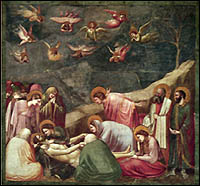Giotto (c. 1266 - c. 1337)

(from the Arena Chapel frescoes)
Full Name: Giotto di Bondone
Country: Italy
Style: Proto-Renaissance
Teachers: Most likely Cimabue
Major Works:
- Madonna Enthroned (c. 1310)
- Arena Chapel Frescoes (c.1304) - 38 paintings on the life of Christ
- Santa Croce Frescoes (?) - Frescoes on the lives of St. John and St. Francis
Interesting Stuff: The emergence of Giotto signaled the beginning of the Renaissance in Italy. His style of painting broke so radically from the past that influences on his style are still being debated today. To imagine art without Giotto is to imagine jazz without Charlie Parker.
Imagine rock and roll without Winger.... wait, umm, try to imagine rock without Quiet Riot, ummm... OK, try imagining rock and roll without some really important guy who changed a lot of stuff. That's how important Giotto was to painting. Seriously though, he was such a sensation in his time that he was mentioned in writings by Petrarch and in Dante's Divine Comedy.
Sometimes called the "father of western pictoral art", his painting turned from the flatter, more iconic Byzantine style to a more naturalistic approach. A firm proponent of using observation of nature to learn about art, his painting emphasized some major characteristics of modern representational art; sculptural solidity, weight/mass of figures, and dimensionality.
While primarily a muralist, it's interesting to note that he was an architect as well. Some say he must have designed the Arena Chapel for the paintings to have fit so well in its design. Late in his career, he took over as chief architect of the cathedral in his home of Florence, where he designed the campanile next to the cathedral - a structure now known as "Giotto's Tower".